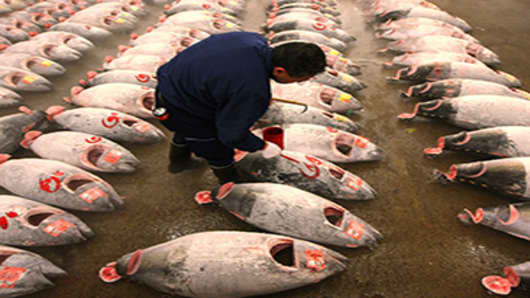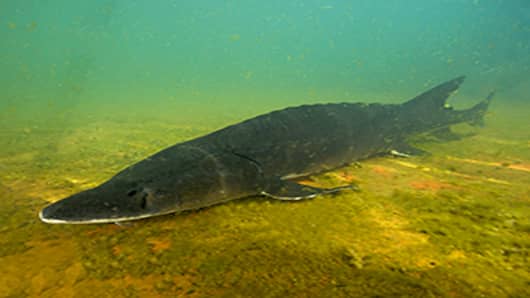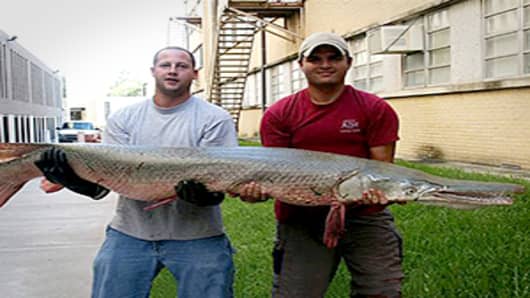On August 21, The Telegraphreported that a fisherman had caught an extremely rare bahaba off the coast of Fujian Province in China. The fish weighed 176 pounds, and at £1,700 a pound, the fisherman collected £300,000 for the fish, or over $475,000.
The bahaba fetches high market prices for its swim bladder, which is used in Chinese medicine to treat lung and heart ailments. The fish has been known to exceed 200 pounds, so despite the impressive size of the August 21 catch, there have been larger specimens out there that yielded even higher paydays, such as one caught in south China in 2010 that sold for $540,000.
As impressive a haul as that is, it didn’t represent the highest known payday for something caught from the sea. There have been other fish worth hundreds of thousands of dollars more, and even though they represent the exception, they’re out there nonetheless. The sea is home to fish that people don’t mind paying a lot of money for, and that makes $7.99 for a pound of salmon look like chump change in comparison.
$737,000 Mega-Fish
On January 5, a Japanese fishing industry still reeling from the March 2011 tsunami got a much-needed shot in the arm. On that day, a Bluefin tuna weighing almost 592 pounds was caught near the seaside Japanese town of Oma.
Normally, when a large fish is sold at Tokyo’s Tsukiji central fish market, the purchase is split between a local bar and a Hong Kong restaurant chain. This time, the fish was purchased in its entirety by a Japanese company.
The tuna was purchased by the Kiyomura Company in Tokyo for a record-setting $736,700, or approximately $1,244 a pound. The company that made the massive purchase owns the Sushi Zanmai restaurant chain, and owner Kiyoshi Kimura told The Wall Street Journal that rather than split the cost with a foreign company, he wanted this to be a purely Japanese purchase.
“Rather than having it taken away overseas, I wish for Japanese people to eat good tuna together,” he said. “Despite the March 11 earthquake and the sluggish economy, I want to lift up Japan’s spirits, urging people to work hard together.”
'Like Winning the Lotto'
While the $736,700 Bluefin was an exceptional find, such fish bring in an impressive haul only when they're handled in the right way.
On August 3, Irish fisherman Tom Kennedy caught a Bluefin off the coastal town of Dingle. It didn’t quite measure up to the Oma catch, but it was pretty impressive nonetheless, weighing in at 308 pounds.
Unfortunately, he was unable to sell his catch in Japan and live off the proceeds. Japanese regulations require that any fish to be used in sushi must be frozen within 20 minutes of being caught, which Kennedy sadly failed to do.
Kevin Flannery, director of the Dingle Oceanworld aquarium, told The Irish Sun that Kennedy now stood to earn only "a few hundred Euro," and would have been singing a happier tune if he had been able to sell it in Japan. "It would be like winning the lotto," Flannery said. "Bluefin tuna is the most expensive commercially caught fish."
Flannery tried to put a happy face on the scenario, saying that Japan’s loss was now Ireland’s gain. Local fish and chips shops would have plenty of delicious Bluefin on hand to enjoy for the entire week.
Black Market Delicacy
As the discriminating gourmand is no doubt aware, the beluga sturgeon from the Caspian Sea is the source of beluga caviar, a luxury commodity that’s synonymous with high-end elegance. The International Union for Conservation of Nature lists it as "critically endangered," the highest-risk category on the IUCN Red List of Threatened Species, and the caviar was banned in the United States by the Fish and Wildlife Service in 2005.
At the time of the ban, beluga caviar sold for $200 an ounce, and 60 percent of all worldwide consumption took place in the United States. The ban allowed some U.S. companies to take up the slack, such as the California Caviar Company, which sells caviar from locally-farmed sturgeon that retails for $80 an ounce.
Legal outlets sell caviar with tastes and textures very similar to the banned variety, but for some people, it just ain’t the same. These people are willing to pay much higher prices for the real thing on the black market, and a 2010 report from the International Centre for Trade and Sustainable Development quoted caviar importer Armen Petrossian, who estimated that one ounce of beluga caviar from the Caspian Sea can fetch as much as $500.
A Fish to Die For
Fugu is the Japanese word for pufferfish. Eating it has the potential to be very costly, and not just in the traditional sense. The fugu’s organs contain tetrodotoxin, a deadly poison that asphyxiates its victim if ingested. Common sense dictates that people would stay as far away from fugu as possible, but it’s actually a delicacy for which some people pay handsomely.
To prepare the fish for safe consumption, Japanese chefs are required to undergo up to three years of apprenticeship, followed by a licensing exam and, finally, eating the fish that they themselves have prepared for the first time. If they don’t succumb to paralysis, muscle shutdown and ultimately death, then they pass.
One might assume that the person who would order this meal is a very aggressive, type A personality, possibly one who is hoping to impress his girlfriend. Jameson Parvizad, general manager of the Blowfish To Die For restaurant in San Francisco, Calif. insists that this is not the case. “The kind of people who order it are people that are foodies, and are really down to try something that isn't offered anywhere else,” he said in an interview.
Adventurous Americans wishing to try fugu stateside should be comforted by the fact that chefs have had to receive extensive training similar to that of Japanese fugu chefs in order to prepare the dish. Blowfish To Die For has a single, dedicated chef whose job it is to prepare the restaurant’s special six-course meal for two. The price for an adventurous couple to dine with death is $280.
The Half-Ton Sturgeon
In 2009, a British couple by the name of Margaret and Michael Snell vacationed near Vancouver, B.C., and caught a white sturgeon that was almost five feet in length. Perhaps hoping to catch lightning in a bottle for a second time, they returned to the Fraser River in July 2012.
Against all odds, they caught another white sturgeon, but this one dwarfed the 2009 catch. After a 45-minute struggle, Michael Snell caught a glimpse of the whole fish from head to tail, and was stunned by what he saw. The fish was almost 12.5 feet long and weighed just over 1,102 pounds.
With the help of his wife and their guide, Dean Werk, Snell brought the fish to shore, and Werk later said that it may have been one of the biggest fish ever caught in North America. They took some pictures and released it back into the river.
Smoked sturgeon sells for as much as $66 a pound, so some may grouse at the more than $70,000 of retail value that the Snells allowed to swim away. However, the white sturgeon is an endangered species, and killing and selling one is a non-starter. One can, however, adopt one through the Fraser River Sturgeon Conservation Society for as little as $100.
A Ray-Finned River Treasure
People who don’t spend a lot of time in the southeastern U.S. may not know about Alligator Gar. It’s a ray-finned fish with fearsome rows of teeth and an elongated snout reminiscent of an alligator, and it’s the largest freshwater fish in North America.
On February 14, 2011, Kenny Williams of Vicksburg, Miss. caught one that weighed in at 327 pounds. The Mississippi Department of Wildlife, Fisheries & Parks said that it was the largest one ever recorded in state history.
Although not widely used as a food source, Alligator gar does wind up on dinner plates. Mouthwatering recipes, such as one that shows how to make fried Alligator gar hush puppies and another for a stir-fry with onions and hot sauce, exist on various websites.
Alligator gar meat sells for $3 a pound, according to Bass Pro Shops, which could have netted Kenny Williams $981 for his Valentine’s Day catch. Instead, he donated it to the Mississippi Museum of Natural Science in Jackson, where it is slated to go on display in the near future, according to Dr. Matthew Roberts, Curator of Fishes for the museum.
'It would break your arm."
In February, a lobster measuring 40 inches in length was caught in a shrimp net off the coast of Maine. More impressive than its size, however, was the fact that the oversized crustacean weighed in at an awe-inspiring 27 pounds.
"All the weight is in the claws," said Elaine Jones, education director for Maine's Department of Marine Resources, of the lobster that was dubbed “Rocky” after its capture. "It would break your arm."
Despite his impressive size, “Rocky” wouldn’t have commanded an impressive price this past summer at restaurants. Lobster prices plummeted in May due to unusually warm weather that caused the crustaceans to appear in fishermen’s traps in much greater numbers than usual. With supply far outweighing demand, prices dropped to 20-year lows of as little as $4 a pound, and “Rocky” could have fed a family of 27 for just $108.
Fortunately, his immense proportions saved his life. Maine law stipulates that any lobster measuring more than five inches from its eyes to the start of its tail must be released, and “Rocky” far exceeds those proportions. He was released into the Atlantic Ocean on February 23.









